Ритоны
Ритоны.
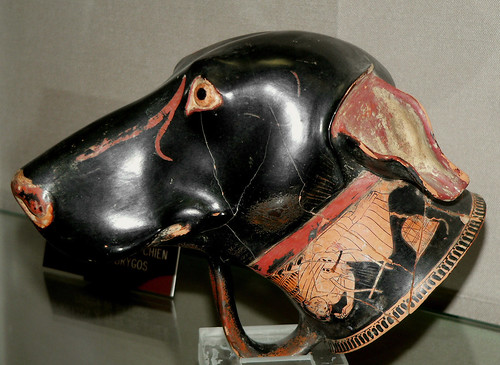


Ритон - сосуд для питья в виде рога животного, они часто использовались в священных обрядах возлияния вина в честь того или иного бога.


Ритоны часто завершались скульптурой в нижней части и украшался рельефами и гравировкой. Делали их как из обычных материалов: глины, кости, рога, так и из цельного серебра и золота.

Верблюд???
An Attic Red-figure Figural Rhyton Attributed to the Tarquinia Painter
460-450 B.C.
--------------------Быки------------------
================================================

---------------------------

Apulian red figure rhyton , c. 400-300 B.C.
Drinking cup in the shape of a bull's head.
Photograph by Brooke Hammerle, courtesy of the Museum of Art, RISD, Providence, RI
--------------------------

Bull Rhyton
Брит. Музей
Naturalistic terracotta rhyton in the form of a bull's head.
------------------
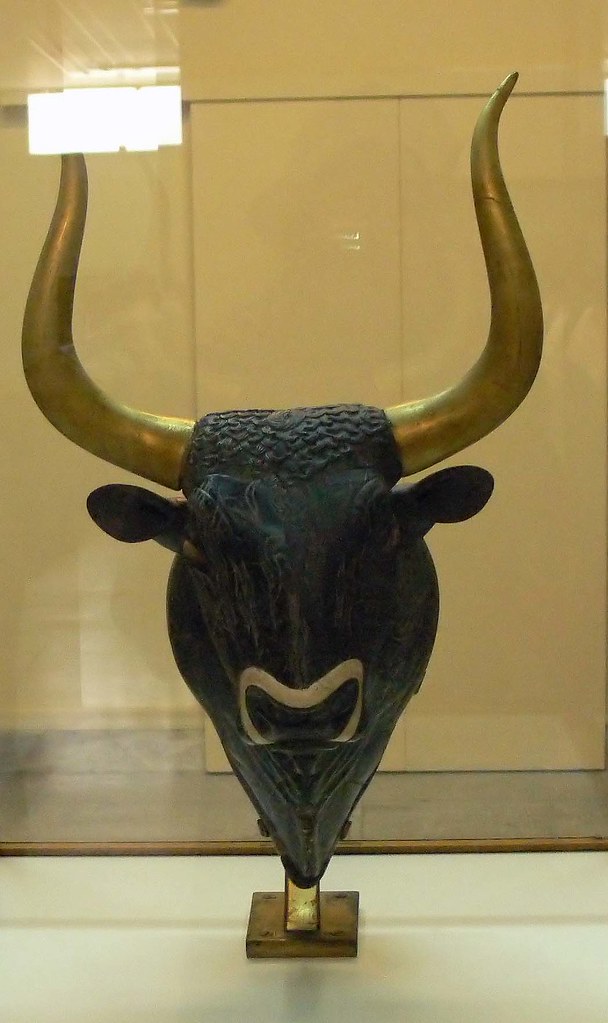
Rhyton in the shape of a bull's head.

Knosso, New Palace Period (1600 - 1500 BC)
-------------------------------------------

Silver repoussé rhyton with gold horns, The National Archaeological Museum of Athens


Bull's Head Rhyton, from Knossos (16 Century BC), Heraklion Museum, Greece

Cow Terracotta Rhyton in the Metropolitan Museum of Art
--------------------Собаки-------------------
==============================================

Rhyton attique à figures rouges en forme de chien

Terracotta rhyton (vase for libations or drinking)
Greek, South Italian, Apulian, red-figure, ca. 350-300 BC
Head of a dog. On the cup, a running satyr.
----------------------Лошади---------------
================================================

Greek Rhyton 6th century BCE
Photographed at the University of Pennsylvania Museum of Archaeology and Anthropology.

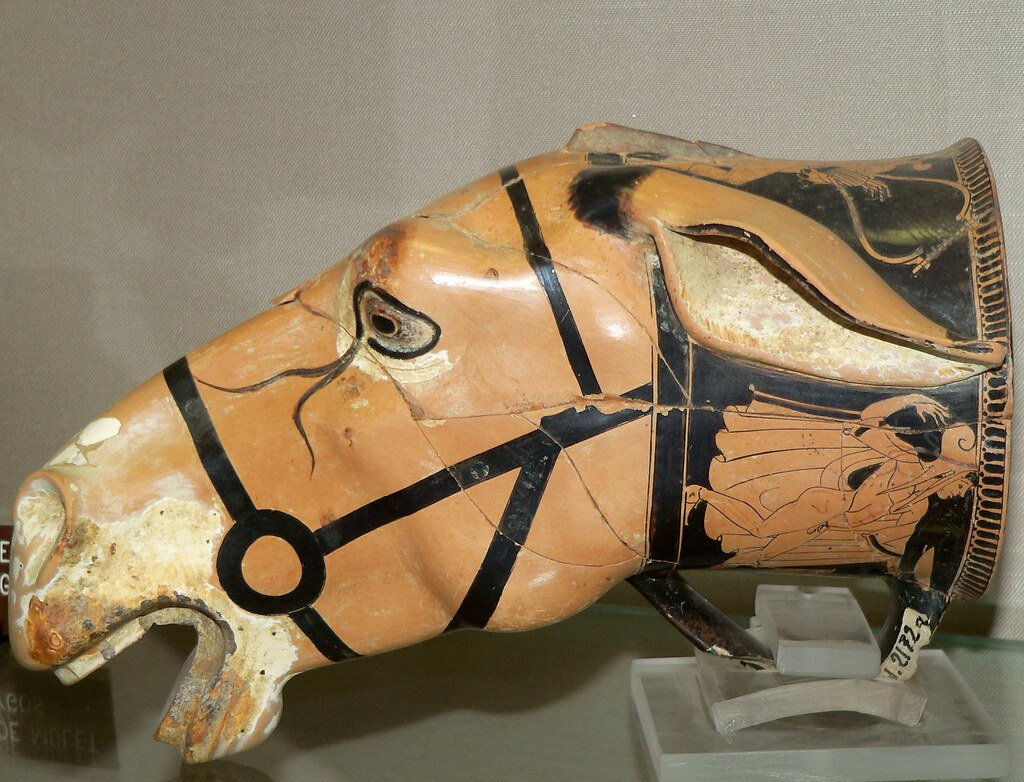
Rhyton attique à figures rouges en forme de mulet
Musée archéologique Jérôme Carcopino, Aleria, Corse.
Ce rhyton provient de la nécropole d'Aleria, tombe n° 91.
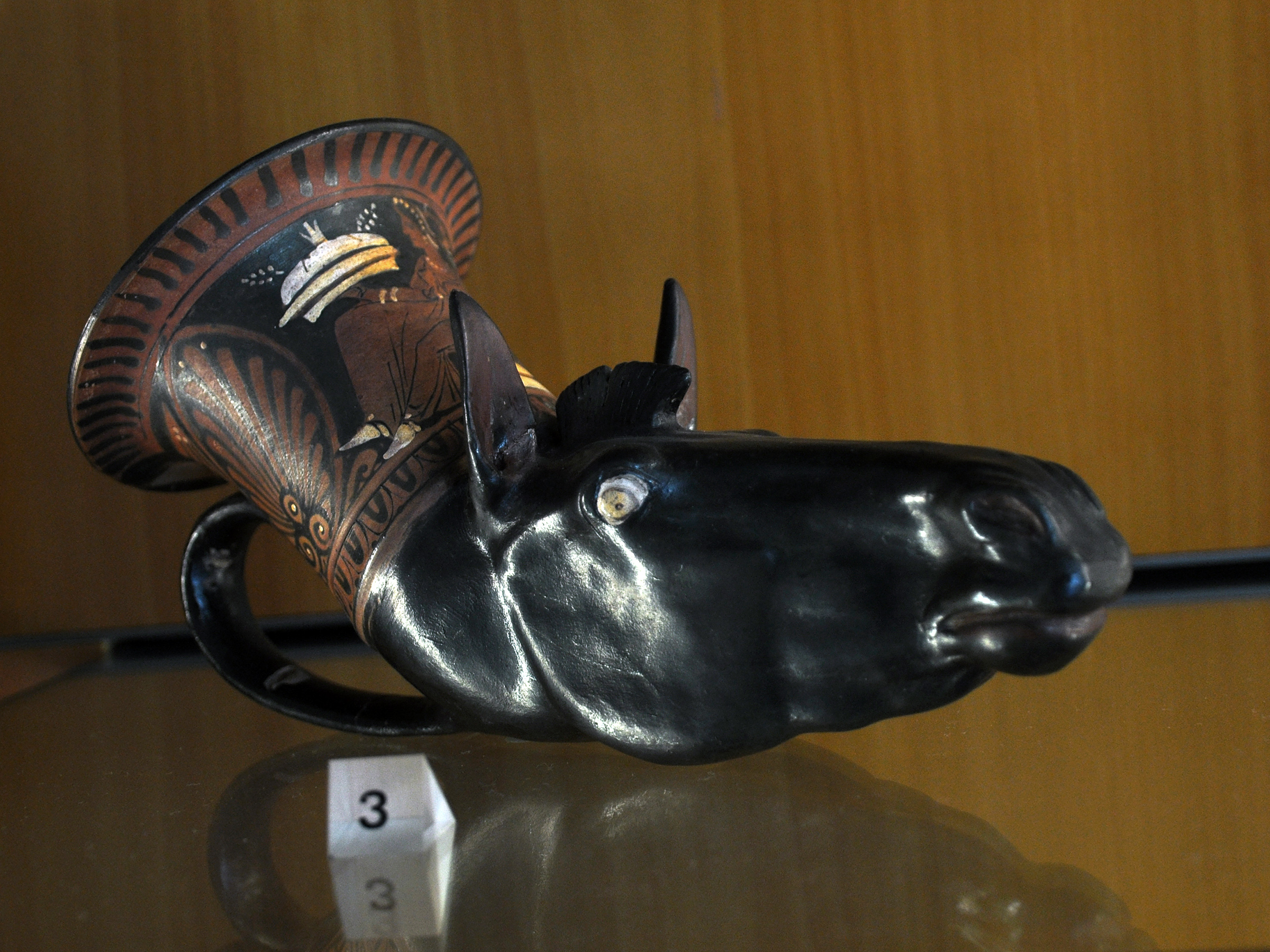
Rhyton en forme de tête de cheval, 4ème siècle - JC, musée des Beaux-Arts de Lyon.
-----------------------Ослы------------------------
=============================================


Rhyton in the shape of a Donkey's Head Greek (Attic) Painted by Douris 460 BCE

rhyton in the shape of a donkey's head representing Dionysos and a maenad. From Athens.
between 440(0440) and 430(0430) BC

Fragmentary Terracotta Attic Red-Figure Rhyton in the Form of a Donkey's Head Attributed to the Manner of the Sotades Painter
Terracotta, Early Classical, ca. 460-450 B.C.E., Attributed to the Manner of the Sotades Painter
------------------Ягнята и овечки---------------
=============================================

A SOUTH ITALIAN POTTERY RAM-HEADED RHYTON

--------------------

Metropolitan Museum of Art
Greek Art of the Fifth Century B.C.

Sheep-headed Rhyton, Attica ca 400 BC
---------------------------------

-----------------------------------------

Man pursuing a woman. Red-figure ram rhyton by the Villa Giulia Painter, ca. 460-450 BC. From Anavyssos in Attica. National Archaeological Museum in Athens

-----------------------------------

Attic red-figure ram-head rhyton, 400-375 BC.
-----------------------------------

Athens, 470 - 460 BC, attributed to Sotades as potter

-------------------------------------

Ram Rhyton
Naturalistic black-glazed terracotta rhyton in the form of a ram's head.

Terracotta Attic Red-Figure Rhyton in the Form of the Head of a Lamb Attributed to the Painter of London E 100
Terracotta, Early Classical, ca. 460 B.C.E., Attributed to the Painter of London E 100
Youths with lyre and double flutes.
-----

The Burrell Collection (Glasgow)
Rhyton
Italie du sud, 4ème siècle avant J.C.
Salles des antiquités égyptiennes, grecques et romaines.


Red-figure Rhyton Drinking Vessel in the Shape of a Sheep's Head Greek attributed to the Painter of Leningrad Tarentum Apulia Italy 340-330 BCE Earthenware
------------------Кабаны-и свинки--------------
============================================

Rhyton depicting head of a pig, terracotta
Sheikh Zenad, 5th century B.C.

Boar's Head
Rhyton (drinking vessel) made in Tarentum, Apulia, Greece, 340 BCE
---------------------Львы-------------
========================================

Gold Rhyton - Athens, National Archeology Museum
"Gold rhyton in the shape of a lion's head from Grave IV of Grave Circle A in Mycenae. It is an exquisite example of Mycenaean embossed work. Dated to the 16th century BCE
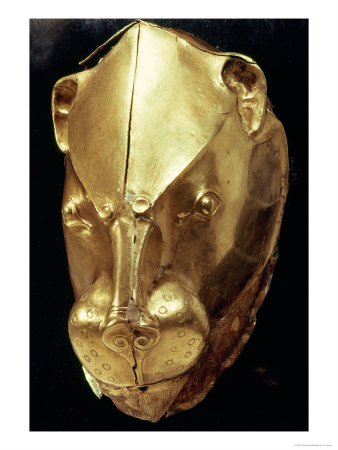
Lion's Head Rhyton, from Grave Circle A, Mycenae, circa 16th Century BC
---------------------------------
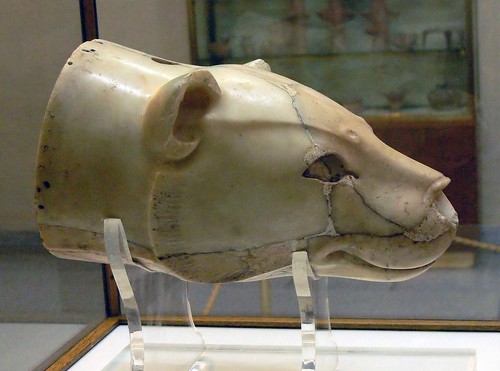
Head of a Lioness


Archaeological Museum in Herakleion. Minoan alabastre rhyton in form of a lioness´ head.
----------------Фантастические------
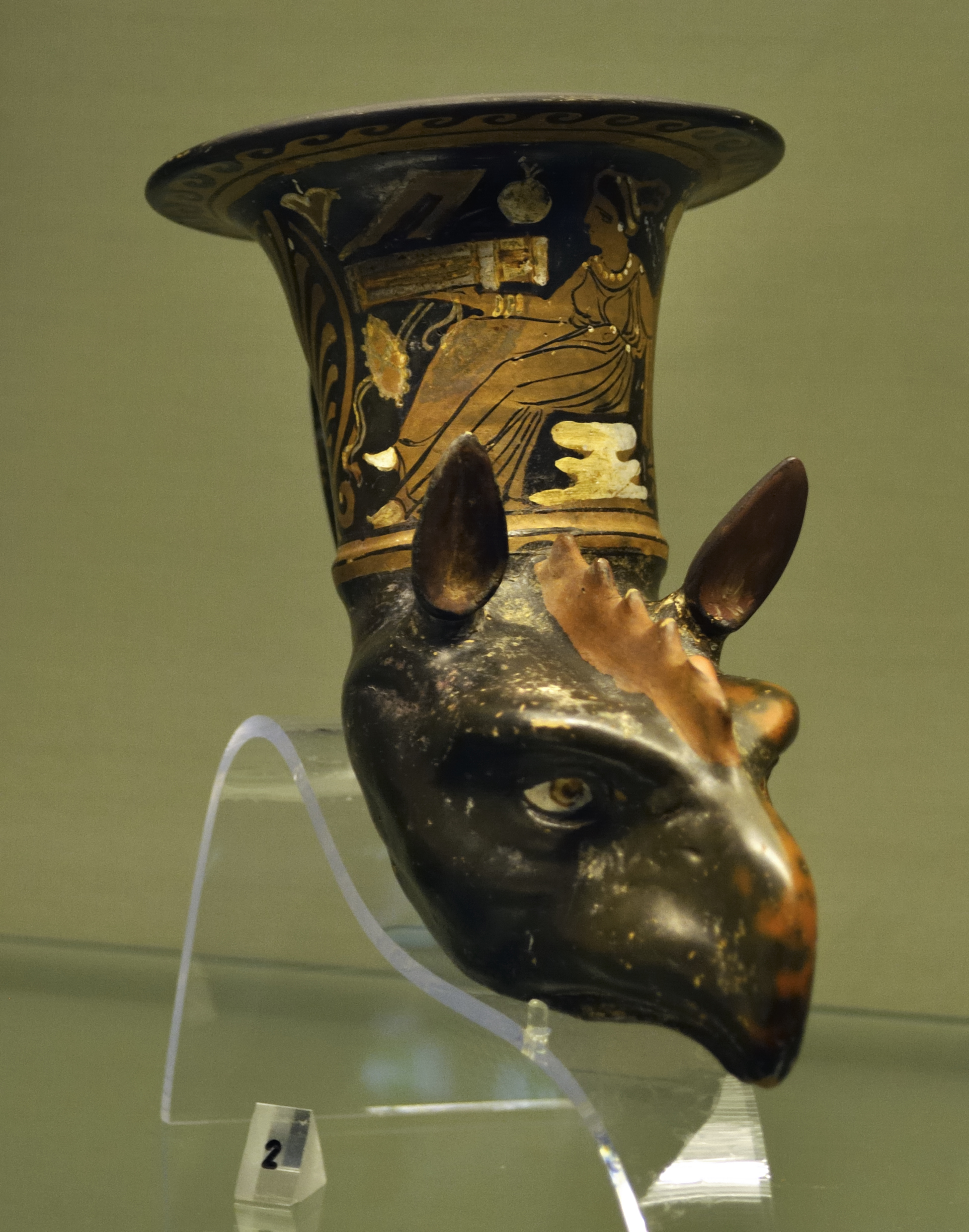
:Apulischer Greifenkopf-Rhyton, Hetjens-Museum Düsseldorf (DerHexer)
-------------------Люди------------
-===========================================

Ethiopian's head and female head, with a kalos inscription. Attic janiform red-figure aryballos, ca. 520-510 BC. From Greece.

Terracotta mug in the form of a woman's head - Greek Art of the Fifth Century B.C. - Metropolitan Museum of Art

Terracotta oinochoe in the form of a woman's head - Greek Art of the Fifth Century B.C. - Metropolitan Museum of Art

British Museum, London
Special drinking vesel (rhyton) in form of Dionysos, Athens, 500-490 BC

Greek art: epinetron
500-400 BC the National Museum of Archeology

Rhyton in shape of negroid child devoured by a crocodile, 460-450 BC.
-----------------Слоновая кость----------------

A Parthian Ivory Rhyton Terminating in the Forepart of a Galloping Winged Centaur with a Woman on His Left Shoulder
Ivory, 2nd Century B.C.E., From Parthia (Nysa)
The rhyton's horn bears the remains of a frieze depicting the Olympian gods around the top. The Parthian artist probably adopted the image of the winged centaur from Greco-Roman art to express local myths and deities related to nature cults.
------------------Золотые-------------------
============================================
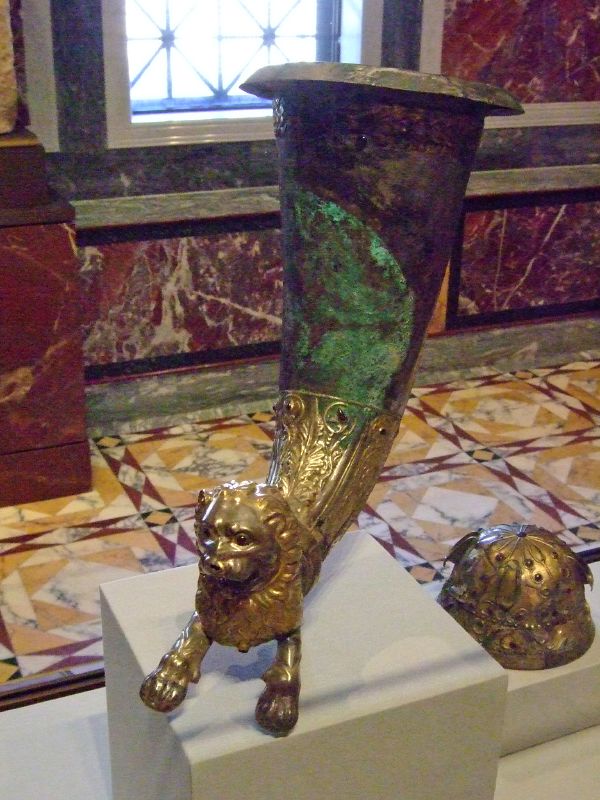
Rhyton (Drinking horn) with lion Parthian 100-1 BCE Silver Gold and Garnet (2)
Photographed at the Getty Villa in Malibu, California.

Treasures of the Odryssian Warriors
The Odrissae Thracian Kingdom reached its most glorious time in the 4th C. B.C.

--------------------------


Pegazus Rhyton (Keleti Művészetek Állami Múzeuma, Moszkva Fotó: Jevgenij Zseltov)
---------------THE PANAGYURISHTE TREASURE ------------




Thracian Gold Treasure from Panagyurishte - Tракийский - Rython - Goat
From the official website of Panagurishte Municipality
THE PANAGYURISHTE TREASURE
(C. 4-3 B.C.)
---------------------



Persian Golden Rhyton
------------------------------

Gold rhyton
Iran, Achaemenid (5 cent. BCE)

Borovo Treasure
discovered in 1974 near the then village of Borovo, Rousse district. The treasure consists of five silver vessels: a large bowl (Jug-Rhyton) and four other rhytons that represent horns
-----------------------СЕРЕБРЯНЫЕ---------------------
====================================================
----------------------------------

Late Classical Greek Silver Janus-Headed Rhyton
--------------------Олени-серебро----------------
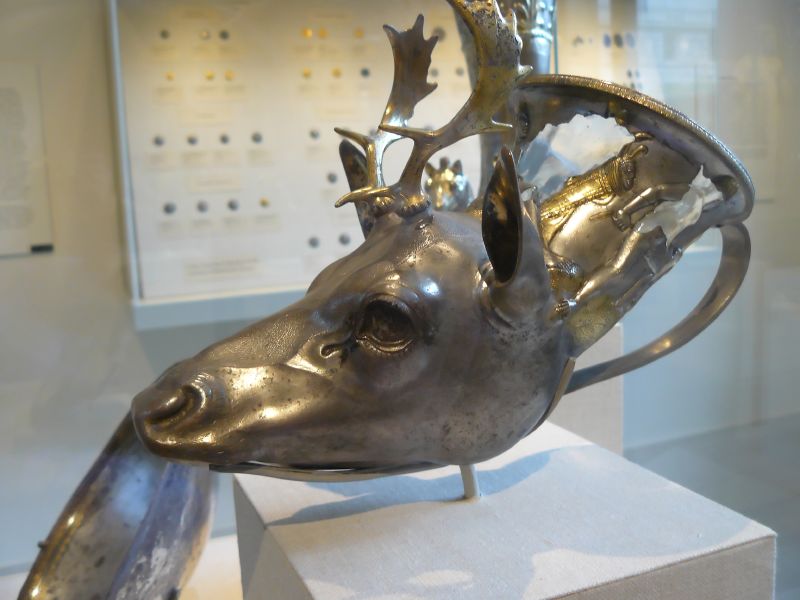
Gilt-silver rhyton in the shape of a stag's head Greek late Classical or Early Hellenistic Period 4th century BCE(2)

-------------------------

Late Classical Greek Silver Rhyton in Form of a Stag's Head
Silver (partially gilt), Late Classical, ca. 400 B.C.E., provincial Greek work, Allegedly from the Black Sea Region
Weight: 829.24 g.; L. 29 cm.

Late Classical Greek Silver Rhyton in the Form of a Deer's Head
Silver (partially gilt), Late Classical, early 4th century B.C.E., Local work under Greek influence, allegedly from the region of the Black Sea
Weight: 565.63 g.; L. 25.4 cm.
-----------------Разные животные----------------

Sofia - Silver Rhyton with Animal Head from Golyamata Mogila
This silver-gilted rhyton was part of the burial gifts of an Odrysian Aristocrat, discovered in Golyamata Mogila (the Big Tumulus), situated between the villages of Zlatinitsa and Malomirovo in the Yambol Region, Bulgaria. It is dated to the mid 4th century BC. It is decorated with a boar-hunting scene.

Bull Rhyton from Central Anatolia Hittite at Met c
--------------------

Рим
-----------------Achaemenid Silver ---------------

Achaemenid Fragmentary Silver Rhyton with a Horse Protome
Silver, 5th-early 4th century B.C.E.
H. 27 cm.

Achaemenid Gilded Silver Rhyton with a Stag Protome
Silver with gold foil inlay, 5th-4th century B.C.E.
H. 31 cm.

An Exceptional Parthian Silver, Gold, Garnet, and Glass Rhyton with the Forepart of a Stag, an Aramaic Inscription Dedicating the Rhyton to Artemis on the Underbelly
Silver, gold, garnet, and glass, second half of the first century B.C.E. - first half of the first century C.E.
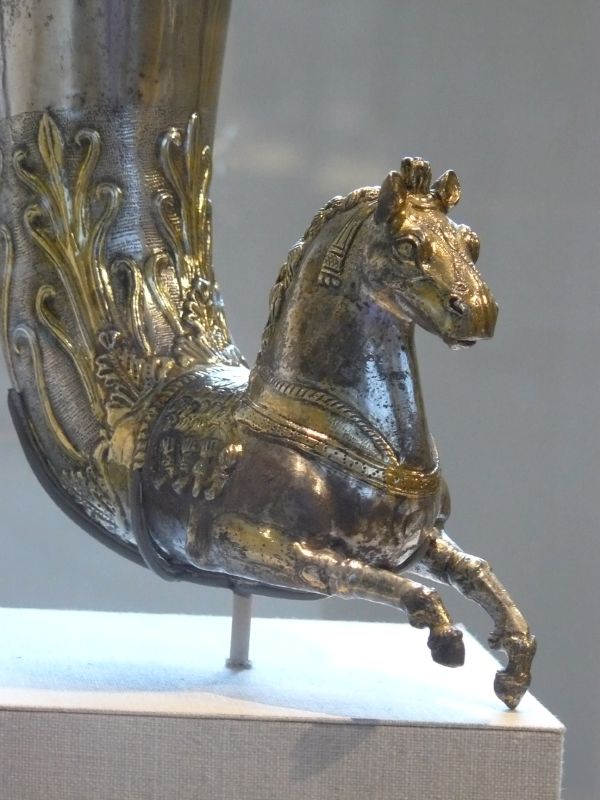
Silver-gilt rhyton for libations or drinking Greco-Parthian Hellenistic 2nd century BCE (2)
the Metropolitan Museum of Art

High/Late Classical Greek Silver Gilt Fragmentary Rhyton in the Form of the Forepart of a Griffin
Silver with gilding, 5th-4th century B.C.E.
H. 11 cm.

Parthian Silver Rhyton with a Caracal Cat and a Fowl
Late 1st century B.C.E., H. 27 cm.
This stunning rhyton or drinking horn depicts the protome (forepart) of a desert lynx (caracal cat, Felis caracal), clutching a desperate cockerel in his paws. This object was made in two major parts - the horn and separately manufactured protome of the lynx and bird.

Rhyton at Toledo Museum of Art
-------------------Graeco-Persian.-----------
==============================================
----------------------Серебряные---------

Silver horn-shaped rhyton from Iran (Persia)

Silver horn-shaped rhyton from Iran (Persia)
Location British Museum
-----------------------
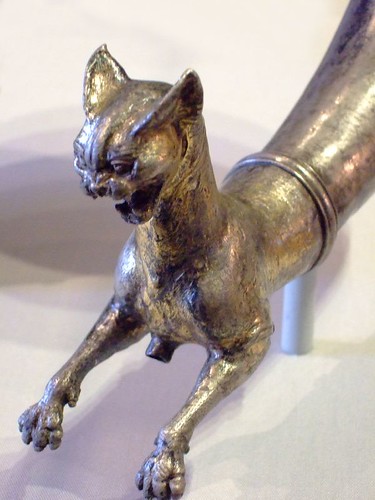
Drinking horn (Rhyton) with Lynx Parthian 50-1 BCE Silver and gold (1)
Photographed at the Getty Villa in Malibu, California.
-------------------Graeco-Persian.-----------

Rhyton (drinking vessel).
Graeco-Persian.
Silver with foil gilding.
200-100 B.C.

Rhyton (drinking vessel).
Silver with foil gilding.
200-100 B.C.
Weight: 1,14 kg.
The Toledo Museum of Art, Toledo, Ohio, USA..
==============================================

Cream jug
Artist: French, Sèvres
Hard-paste porcelain
1813

Marble rhyton on the northeast corner of the Rayburn House Office Building (built: 1962-65), Washington, DC
--------------------Современные-------------------


Goat Head Rhyton
Beth Cavener Stichter
http://www.followtheblackrabbit.com/index_main.htm
===================================
Еще по теме:

Сосуд для питья с механизмом и богиней Дианой.



Чаши для питья в форме птиц.
Драгоценная утварь.Столовые приборы-ТУТ

Серебряные молочники в виде коровы-ТУТ


Старинные нефы и кубки-наутилусы-ТУТ


КУБКИ- "НАУТИЛУСЫ" И ДРУГИЕ РЕДКОСТИ-ТУТ
===================================
rhyton
http://www.flickr.com/search/groups/?q=rhyton&w=892403%40N23&m=pool
http://www.flickr.com/search/?w=all&q=rhyton&m=text
http://www.flickr.com/search/groups/?m=pool&w=492405%40N20&q=rhyton
http://www.flickr.com/search/groups/?q=rhyton&w=33752266%40N00&m=pool
http://www.flickr.com/search/groups/?q=rhyton&w=34659378%40N00&m=pool
http://www.google.ru/images?um=1&hl=ru&newwindow=1&client=firefox&rls=org.mozilla:ru:official&biw=1573&bih=830&tbs=isch:1&btnG=%D0%9F%D0%BE%D0%B8%D1%81%D0%BA&aq=f&aqi=&oq=&gs_rfai=&q=Rhyton
http://en.wikipedia.org/wiki/Rhyton
http://www.omda.bg/engl/history/panagyurishte_treasure.htm

Ритон - сосуд для питья в виде рога животного, они часто использовались в священных обрядах возлияния вина в честь того или иного бога.


Ритоны часто завершались скульптурой в нижней части и украшался рельефами и гравировкой. Делали их как из обычных материалов: глины, кости, рога, так и из цельного серебра и золота.

Верблюд???
An Attic Red-figure Figural Rhyton Attributed to the Tarquinia Painter
460-450 B.C.
--------------------Быки------------------
================================================

---------------------------

Apulian red figure rhyton , c. 400-300 B.C.
Drinking cup in the shape of a bull's head.
Photograph by Brooke Hammerle, courtesy of the Museum of Art, RISD, Providence, RI
--------------------------

Bull Rhyton
Брит. Музей
Naturalistic terracotta rhyton in the form of a bull's head.
------------------

Rhyton in the shape of a bull's head.

Knosso, New Palace Period (1600 - 1500 BC)
-------------------------------------------

Silver repoussé rhyton with gold horns, The National Archaeological Museum of Athens


Bull's Head Rhyton, from Knossos (16 Century BC), Heraklion Museum, Greece
Cow Terracotta Rhyton in the Metropolitan Museum of Art
--------------------Собаки-------------------
==============================================

Rhyton attique à figures rouges en forme de chien

Terracotta rhyton (vase for libations or drinking)
Greek, South Italian, Apulian, red-figure, ca. 350-300 BC
Head of a dog. On the cup, a running satyr.
----------------------Лошади---------------
================================================

Greek Rhyton 6th century BCE
Photographed at the University of Pennsylvania Museum of Archaeology and Anthropology.


Rhyton attique à figures rouges en forme de mulet
Musée archéologique Jérôme Carcopino, Aleria, Corse.
Ce rhyton provient de la nécropole d'Aleria, tombe n° 91.

Rhyton en forme de tête de cheval, 4ème siècle - JC, musée des Beaux-Arts de Lyon.
-----------------------Ослы------------------------
=============================================


Rhyton in the shape of a Donkey's Head Greek (Attic) Painted by Douris 460 BCE

rhyton in the shape of a donkey's head representing Dionysos and a maenad. From Athens.
between 440(0440) and 430(0430) BC

Fragmentary Terracotta Attic Red-Figure Rhyton in the Form of a Donkey's Head Attributed to the Manner of the Sotades Painter
Terracotta, Early Classical, ca. 460-450 B.C.E., Attributed to the Manner of the Sotades Painter
------------------Ягнята и овечки---------------
=============================================

A SOUTH ITALIAN POTTERY RAM-HEADED RHYTON

--------------------
Metropolitan Museum of Art
Greek Art of the Fifth Century B.C.

Sheep-headed Rhyton, Attica ca 400 BC
---------------------------------

-----------------------------------------

Man pursuing a woman. Red-figure ram rhyton by the Villa Giulia Painter, ca. 460-450 BC. From Anavyssos in Attica. National Archaeological Museum in Athens

-----------------------------------

Attic red-figure ram-head rhyton, 400-375 BC.
-----------------------------------

Athens, 470 - 460 BC, attributed to Sotades as potter

-------------------------------------

Ram Rhyton
Naturalistic black-glazed terracotta rhyton in the form of a ram's head.

Terracotta Attic Red-Figure Rhyton in the Form of the Head of a Lamb Attributed to the Painter of London E 100
Terracotta, Early Classical, ca. 460 B.C.E., Attributed to the Painter of London E 100
Youths with lyre and double flutes.
-----

The Burrell Collection (Glasgow)
Rhyton
Italie du sud, 4ème siècle avant J.C.
Salles des antiquités égyptiennes, grecques et romaines.


Red-figure Rhyton Drinking Vessel in the Shape of a Sheep's Head Greek attributed to the Painter of Leningrad Tarentum Apulia Italy 340-330 BCE Earthenware
------------------Кабаны-и свинки--------------
============================================

Rhyton depicting head of a pig, terracotta
Sheikh Zenad, 5th century B.C.

Boar's Head
Rhyton (drinking vessel) made in Tarentum, Apulia, Greece, 340 BCE
---------------------Львы-------------
========================================

Gold Rhyton - Athens, National Archeology Museum
"Gold rhyton in the shape of a lion's head from Grave IV of Grave Circle A in Mycenae. It is an exquisite example of Mycenaean embossed work. Dated to the 16th century BCE

Lion's Head Rhyton, from Grave Circle A, Mycenae, circa 16th Century BC
---------------------------------

Head of a Lioness


Archaeological Museum in Herakleion. Minoan alabastre rhyton in form of a lioness´ head.
----------------Фантастические------
:Apulischer Greifenkopf-Rhyton, Hetjens-Museum Düsseldorf (DerHexer)
-------------------Люди------------
-===========================================

Ethiopian's head and female head, with a kalos inscription. Attic janiform red-figure aryballos, ca. 520-510 BC. From Greece.
Terracotta mug in the form of a woman's head - Greek Art of the Fifth Century B.C. - Metropolitan Museum of Art
Terracotta oinochoe in the form of a woman's head - Greek Art of the Fifth Century B.C. - Metropolitan Museum of Art

British Museum, London
Special drinking vesel (rhyton) in form of Dionysos, Athens, 500-490 BC

Greek art: epinetron
500-400 BC the National Museum of Archeology

Rhyton in shape of negroid child devoured by a crocodile, 460-450 BC.
-----------------Слоновая кость----------------

A Parthian Ivory Rhyton Terminating in the Forepart of a Galloping Winged Centaur with a Woman on His Left Shoulder
Ivory, 2nd Century B.C.E., From Parthia (Nysa)
The rhyton's horn bears the remains of a frieze depicting the Olympian gods around the top. The Parthian artist probably adopted the image of the winged centaur from Greco-Roman art to express local myths and deities related to nature cults.
------------------Золотые-------------------
============================================

Rhyton (Drinking horn) with lion Parthian 100-1 BCE Silver Gold and Garnet (2)
Photographed at the Getty Villa in Malibu, California.

Treasures of the Odryssian Warriors
The Odrissae Thracian Kingdom reached its most glorious time in the 4th C. B.C.

--------------------------


Pegazus Rhyton (Keleti Művészetek Állami Múzeuma, Moszkva Fotó: Jevgenij Zseltov)
---------------THE PANAGYURISHTE TREASURE ------------




Thracian Gold Treasure from Panagyurishte - Tракийский - Rython - Goat
From the official website of Panagurishte Municipality
THE PANAGYURISHTE TREASURE
(C. 4-3 B.C.)
---------------------



Persian Golden Rhyton
------------------------------

Gold rhyton
Iran, Achaemenid (5 cent. BCE)

Borovo Treasure
discovered in 1974 near the then village of Borovo, Rousse district. The treasure consists of five silver vessels: a large bowl (Jug-Rhyton) and four other rhytons that represent horns
-----------------------СЕРЕБРЯНЫЕ---------------------
====================================================
----------------------------------

Late Classical Greek Silver Janus-Headed Rhyton
--------------------Олени-серебро----------------

Gilt-silver rhyton in the shape of a stag's head Greek late Classical or Early Hellenistic Period 4th century BCE(2)

-------------------------

Late Classical Greek Silver Rhyton in Form of a Stag's Head
Silver (partially gilt), Late Classical, ca. 400 B.C.E., provincial Greek work, Allegedly from the Black Sea Region
Weight: 829.24 g.; L. 29 cm.

Late Classical Greek Silver Rhyton in the Form of a Deer's Head
Silver (partially gilt), Late Classical, early 4th century B.C.E., Local work under Greek influence, allegedly from the region of the Black Sea
Weight: 565.63 g.; L. 25.4 cm.
-----------------Разные животные----------------

Sofia - Silver Rhyton with Animal Head from Golyamata Mogila
This silver-gilted rhyton was part of the burial gifts of an Odrysian Aristocrat, discovered in Golyamata Mogila (the Big Tumulus), situated between the villages of Zlatinitsa and Malomirovo in the Yambol Region, Bulgaria. It is dated to the mid 4th century BC. It is decorated with a boar-hunting scene.

Bull Rhyton from Central Anatolia Hittite at Met c
--------------------

Рим
-----------------Achaemenid Silver ---------------

Achaemenid Fragmentary Silver Rhyton with a Horse Protome
Silver, 5th-early 4th century B.C.E.
H. 27 cm.

Achaemenid Gilded Silver Rhyton with a Stag Protome
Silver with gold foil inlay, 5th-4th century B.C.E.
H. 31 cm.

An Exceptional Parthian Silver, Gold, Garnet, and Glass Rhyton with the Forepart of a Stag, an Aramaic Inscription Dedicating the Rhyton to Artemis on the Underbelly
Silver, gold, garnet, and glass, second half of the first century B.C.E. - first half of the first century C.E.

Silver-gilt rhyton for libations or drinking Greco-Parthian Hellenistic 2nd century BCE (2)
the Metropolitan Museum of Art

High/Late Classical Greek Silver Gilt Fragmentary Rhyton in the Form of the Forepart of a Griffin
Silver with gilding, 5th-4th century B.C.E.
H. 11 cm.

Parthian Silver Rhyton with a Caracal Cat and a Fowl
Late 1st century B.C.E., H. 27 cm.
This stunning rhyton or drinking horn depicts the protome (forepart) of a desert lynx (caracal cat, Felis caracal), clutching a desperate cockerel in his paws. This object was made in two major parts - the horn and separately manufactured protome of the lynx and bird.

Rhyton at Toledo Museum of Art
-------------------Graeco-Persian.-----------
==============================================
----------------------Серебряные---------

Silver horn-shaped rhyton from Iran (Persia)

Silver horn-shaped rhyton from Iran (Persia)
Location British Museum
-----------------------

Drinking horn (Rhyton) with Lynx Parthian 50-1 BCE Silver and gold (1)
Photographed at the Getty Villa in Malibu, California.
-------------------Graeco-Persian.-----------

Rhyton (drinking vessel).
Graeco-Persian.
Silver with foil gilding.
200-100 B.C.

Rhyton (drinking vessel).
Silver with foil gilding.
200-100 B.C.
Weight: 1,14 kg.
The Toledo Museum of Art, Toledo, Ohio, USA..
==============================================

Cream jug
Artist: French, Sèvres
Hard-paste porcelain
1813

Marble rhyton on the northeast corner of the Rayburn House Office Building (built: 1962-65), Washington, DC
--------------------Современные-------------------


Goat Head Rhyton
Beth Cavener Stichter
http://www.followtheblackrabbit.com/index_main.htm
===================================
Еще по теме:

Сосуд для питья с механизмом и богиней Дианой.



Чаши для питья в форме птиц.
Драгоценная утварь.Столовые приборы-ТУТ

Серебряные молочники в виде коровы-ТУТ

Старинные нефы и кубки-наутилусы-ТУТ


КУБКИ- "НАУТИЛУСЫ" И ДРУГИЕ РЕДКОСТИ-ТУТ
===================================
rhyton
http://www.flickr.com/search/groups/?q=rhyton&w=892403%40N23&m=pool
http://www.flickr.com/search/?w=all&q=rhyton&m=text
http://www.flickr.com/search/groups/?m=pool&w=492405%40N20&q=rhyton
http://www.flickr.com/search/groups/?q=rhyton&w=33752266%40N00&m=pool
http://www.flickr.com/search/groups/?q=rhyton&w=34659378%40N00&m=pool
http://www.google.ru/images?um=1&hl=ru&newwindow=1&client=firefox&rls=org.mozilla:ru:official&biw=1573&bih=830&tbs=isch:1&btnG=%D0%9F%D0%BE%D0%B8%D1%81%D0%BA&aq=f&aqi=&oq=&gs_rfai=&q=Rhyton
http://en.wikipedia.org/wiki/Rhyton
http://www.omda.bg/engl/history/panagyurishte_treasure.htm